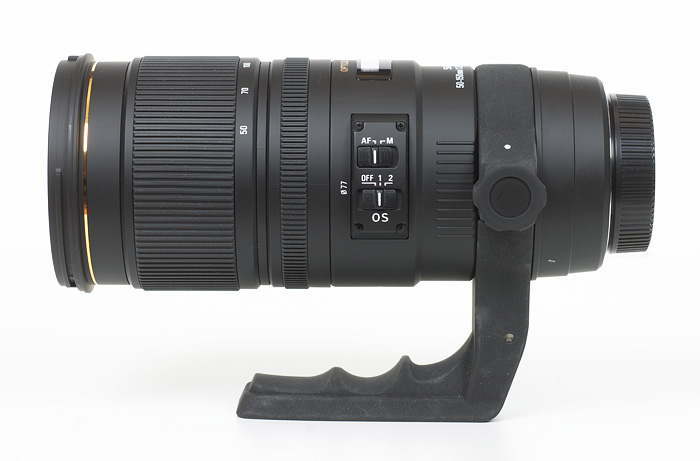|
Page 1 of 3
 Review by Markus Stamm, published August 2013
Review by Markus Stamm, published August 2013
Introduction
There are lots of dedicated APS-C lenses nowadays, but not many manufacturers target the high-end segment of fast DX tele zooms. Among the rare exceptions were Tokina and Pentax, which jointly developed a 50-135mm f/2.8 zoom, but at least the Tokina lens faced a rather short product life and is already discontinued.
The only other manufacturer in this small niche is Sigma. Their 50-150mm f/2.8 DC lens is under active development and has already reached the third generation. The initial 50-150mm f/2.8 DC HSM, dating back to 2006, was replaced by the 50-150/2.8 OS II HSM just one year later. The latest upgrade, announced in 2011, added Sigma's optical stabilization system (OS).
In this review we will have a look at how the OS lens performs on our current DX test camera, the Nikon D7000.

One of the main reasons to consider an APS-C lens over a full-frame design is usually the size advantage of the dedicated crop lens. This is clearly not the case here: the Sigma is huge, in fact its lens barrel is identical in dimensions with the full frame sister lens, the EX 70-200m f/2.8 OS. If one adds the supplied hood, the DX lens is actually larger.
The lens carries the EX designation and thus is part of Sigma's high-end lens collection. Consequently, the build quality is on a very high level. The lens features the rubber-like smooth coating that is typical for current EX lenses.

The focus and zoom rings operate very smoothly and slightly damped. The length of the lens remains constant regardless of the focus and zoom settings. Thanks to an IF (internal focusing) design the front element does not rotate so using a polarizer is no problem. Like all high-end Sigma HSM lenses it features a hypersonic AF motor providing very fast and silent AF operations as well as manual focus override at any time. In addition, because of the HSM drive the lens offers fully AF functionality on all Nikon DX DSLRs, including the current entry-level models.
Both the zoom and the focus ring work in "Canon" style, which is the exact opposite of how these rings work on Nikkor lenses. If you're used to the Nikon way of zooming, the Sigma lens may be a challenge for your muscle memory. And if you try to focus manually, you'll have to remember that the focus assist in the viewfinder assumes a Nikon lens and consequently suggest the wrong direction of focus ring movement.
Talking about "Canon style": the optical stabilizer (OS) of the Sigma lens offers two modes, that closely match the two modes available on Canon IS lenses. Unlike Nikon VR lenses, which offer a "normal" mode with panning detection and an "active" mode to deal with more pronounced vibrations (but without panning detection), the Sigma features mode 1 for full stabilization of both axis, while mode 2 is designed for panning and limits correction to a direction vertical to the panning movement.
Sigma claims a benefit of up to 4 f-stops for its OS (Optical Stabilizer). However, this seems to be a bit optimistic. You may be lucky at times with shutter speeds that slow but it's more realistic to expect a gain of up to 3 f-stops in field conditions. Subjectively, the OS implementation in this lens performs on the same level as the VR II module in Nikon's current 70-200/2.8 lens.

The lens comes with a removable tripod collar included. In addition, it is compatible with the optional and larger (and somewhat expensive) Sigma TS-41 collar, that offers an increased distance from lens body to mount plate. That additional space makes the setup more comfortable to handhold and carry (also due to the grip's shape) and can also give enough clearance to use the lens with large cameras (or a DSLR with additional battery grip) on some ballheads, on which otherwise the camery body could collide with the head's controls when rotated. On the other hand, the larger collar of course needs a lot more space in your camera bag.
The lens is compatible and offers full AF functionality with both current Sigma APO DG tele converters.
The Sigma AF 50-150mm f/2.8 EX DC OS HSM is a G-type lens and thus does not offer an aperture ring.
| Specifications |
|---|
| Equiv. focal length | 75-225 mm (full format equivalent) |
| Equiv. aperture | f/4.2 (full format equivalent, in terms of depth-of-field) |
| Optical construction | 21 elements in 15 groups inc. 6 SLD elements |
| Number of aperture blades | 9 (rounded) |
| min. focus distance | 0.8 m (max. magnification ratio 1:6.3) |
| Dimensions | 86.4 x 197.6 mm |
| Weight | 1335 g |
| Filter size | 77 mm (non-rotating) |
| Hood | bayonet mount, petal-shaped, supplied |
| Other features | Lens provides distance (D) information. Removable tripod collar. Optical stabilization (OS) |
|